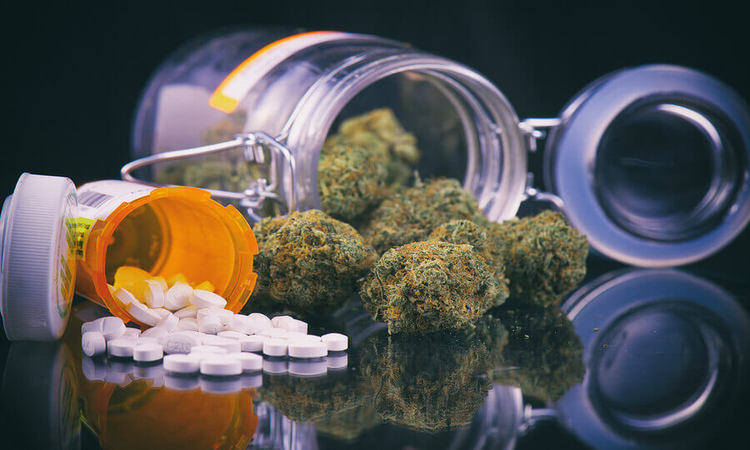
Xanax (alprazolam) and weed (marijuana, cannabis) are two substances that are frequently used and sometimes abuse, and there may be interactions and dangers of using both drugs concurrently. Although the possible interactions and risks of mixing Xanax and weed aren’t well-established, many health professionals believe that combining the two could result in amplified side effects, such as profound drowsiness and poor judgment.
Such effects can be hazardous because a person who is high on weed and using Xanax may put themselves in dangerous situations such as driving. Their combined impact may be unpredictable, and different people will experience different effects, some of which may be unwanted.
Also, marijuana in and of itself can cause distress and anxiety in some people, so for these individuals, marijuana should be avoided, especially when using Xanax. It could undermine the medication’s ability to work effectively.
What Is Xanax?
Xanax is commonly prescribed to treat anxiety, panic disorders, seizures, and, occasionally, insomnia. Xanax is a powerful depressant and works by reducing activity in the central nervous system, which result in a person feeling more relaxed. However, drowsiness, dizziness, and confusion may also occur, and Xanax is considered to have the potential for dependence and addiction.
For this reason, Xanax is only intended to be used for short-term treatment, and it’s important that people only use it with a legitimate prescription and precisely as directed.
What Is Weed?
Weed is a slang name for marijuana, which is an herb derived from the Cannabis plant. In the last few years, many states and municipalities have decriminalized its use or made it legal to use for either medical or recreational purposes.
In light of this, the stigma of marijuana use has further been reduced, particularly as researchers have found that it may have some therapeutic value in many cases. However, marijuana remains illegal in many states, and despite public outcry, the Drug Enforcement Agency has thus far refused to re-classify it, and it remains a Schedule I controlled substance.
When a person ingests marijuana, the active chemical THC binds to certain brain receptors and can induce feelings of euphoria, relaxation, and, in some people, anxiety, and paranoia. Side effects may also include drowsiness, dizziness, or cognition or memory impairments.
Interactions and Dangers of Mixing Xanax and Weed
Although mixing Xanax and weed isn’t as hazardous as mixing Xanax with some other substances, such as opioids or alcohol, potential users are urged to exercise caution. Doing this can amplify the effects of both substances, and result in severe drowsiness, confusion, and profoundly impaired judgment.
Impaired judgment is especially concerning because a person may not be able to make sound decisions that will prevent them from injuring themselves or others. Coordination may also be impaired, making walking and performing regular daily takes challenging or impossible and result in falls or injury.
There is unlikely to be a direct, life-threatening interaction from using Xanax and weed, but complications can occur, such as those aforementioned as well as suicidal thoughts or behaviors.
Getting Treatment for Drug Dependency
By offering a variety of evidence-based treatment options, Recovery By The Sea effectively approaches addiction from multiple angles, which can increase the effectiveness of each element of treatment.
Some of our therapeutic options are as follows:
Group Therapy – Group therapy addresses interpersonal, family, and social struggles and fosters communication and the learning of relationship skills. It also nurtures a shared identity by promoting an allegiance of understanding and loving peers, as well as encourages appropriate attitudes and behaviors.
Individual Therapy – During individual therapy, people will benefit from one-on-one engagement with a licensed, trained therapist in a private, non-judgmental environment. Behavioral therapies are employed, which seek to identify negative thoughts, feelings, and behaviors, and find ways to replace them with ones that are healthy and positive. During therapy, patients are encouraged to explore the connection between their thoughts and behaviors in an effort to gain insight into the root causes of their addiction and understand themselves better. They will be encouraged to work through challenging and negative memories and experiences thoroughly.
Experiential Activities – Experiential activities can provide patients with an alternative way to express their feelings, as well as develop leisure and relaxation skills. These activities promote goal-directed thinking and problem-solving skills. Popular options include art, music, and adventure therapy.
A Comprehensive Approach Is Important for a Long-Term Recovery
Together, the above-mentioned therapies and services can enhance the effects of each other and make the overall treatment plan exponentially more effective than the sum of its parts.
By using a customized, multi-dimensional approach, clients learn better-coping skills to deal with cravings and triggers, prevent relapse, and manage co-occurring mental health conditions, such as anxiety.
If you are suffering from anxiety, other mental health problems, and drug dependence, we urge you to contact us today! Discover how we help people escape the prison of addiction and remain happy and healthy for life!
READ THIS NEXT: Snorting Xanax